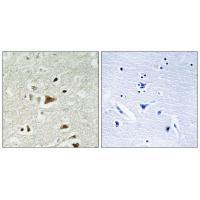

| WB | 咨询技术 | Human,Mouse,Rat |
| IF | 咨询技术 | Human,Mouse,Rat |
| IHC | 1/50-1/100 | Human,Mouse,Rat |
| ICC | 技术咨询 | Human,Mouse,Rat |
| FCM | 咨询技术 | Human,Mouse,Rat |
| Elisa | 咨询技术 | Human,Mouse,Rat |
| Aliases | JV18-1; MADH2; MADR2; Mad-related protein 2; Mothers against DPP homolog 2 |
| Entrez GeneID | 4087; |
| WB Predicted band size | 60kDa |
| Host/Isotype | Rabbit IgG |
| Antibody Type | Primary antibody |
| Storage | Store at 4°C short term. Aliquot and store at -20°C long term. Avoid freeze/thaw cycles. |
| Species Reactivity | Human,Mouse,Rat |
| Immunogen | Synthesized non-phosphopeptide derived from human Smad2 around the phosphorylation site of threonine 220 (P-E-T(p)-P-P). |
| Formulation | Purified antibody in PBS with 0.05% sodium azide. |
+ +
以下是3篇涉及Smad2(Ab-220)抗体的代表性文献,供参考:
---
1. **文献名称**:*TGF-β-induced phosphorylation of Smad2 regulates its interaction with Smad4*
**作者**:Souchelnytskyi S. et al.
**摘要**:研究利用Smad2 (Ab-220)抗体进行免疫沉淀和Western blot,发现TGF-β信号激活后Smad2的磷酸化修饰对其与Smad4的结合至关重要,揭示了Smad蛋白复合体形成的分子机制。
---
2. **文献名称**:*Distinct roles of Smad2 and Smad3 in extracellular matrix remodeling in hepatic fibrosis*
**作者**:Dooley S. et al.
**摘要**:通过Smad2 (Ab-220)特异性抗体检测肝纤维化模型中Smad2的活化状态,证明Smad2(而非Smad3)在细胞外基质重塑中发挥主导作用,为靶向治疗提供依据。
---
3. **文献名称**:*Regulation of Smad2 subcellular localization by phosphorylation in response to TGF-β signaling*
**作者**:Xu L. et al.
**摘要**:结合免疫荧光和Smad2 (Ab-220)抗体,发现Smad2的C端磷酸化驱动其核转位,并解析了TGF-β信号调控Smad2空间动态的关键结构域。
---
**备注**:
- "Ab-220"可能对应不同厂商的特定克隆号(如Santa Cruz的sc-220),建议通过抗体说明书确认具体文献来源。
- 若需具体文献链接或补充,可提供研究领域或应用方向进一步筛选。
Smad2 (Ab-220) antibody is a widely used tool in molecular biology research, specifically targeting the Smad2 protein, a key mediator of the transforming growth factor-beta (TGF-β) signaling pathway. Smad2 belongs to the receptor-regulated Smad (R-Smad) family and plays a critical role in transmitting extracellular signals from TGF-β superfamily ligands (e.g., TGF-β, activin, nodal) to the nucleus. Upon ligand binding, Smad2 is phosphorylated by activated type I receptor kinases at C-terminal serine residues (Ser465/467 in humans), enabling its association with Smad4 and subsequent translocation to the nucleus to regulate gene expression. This pathway is essential for diverse cellular processes, including proliferation, differentiation, apoptosis, and epithelial-mesenchymal transition (EMT).
The Smad2 (Ab-220) antibody, often raised in rabbits as a monoclonal or polyclonal reagent, recognizes endogenous Smad2 protein across various species, including human, mouse, and rat. It typically detects both phosphorylated (activated) and unphosphorylated forms, depending on the immunogen design. Researchers frequently employ this antibody in techniques like Western blotting, immunoprecipitation, and immunofluorescence to investigate Smad2 expression, activation status, and subcellular localization. Its applications extend to studying TGF-β signaling dysregulation in pathologies such as cancer, fibrosis, and autoimmune diseases. The "Ab-220" designation may refer to a specific clone or epitope-targeting region (e.g., central linker domain), which ensures specificity by minimizing cross-reactivity with homologous proteins like Smad3. Proper validation using Smad2 knockout controls or siRNA-mediated knockdown is recommended to confirm antibody specificity in experimental systems.
×